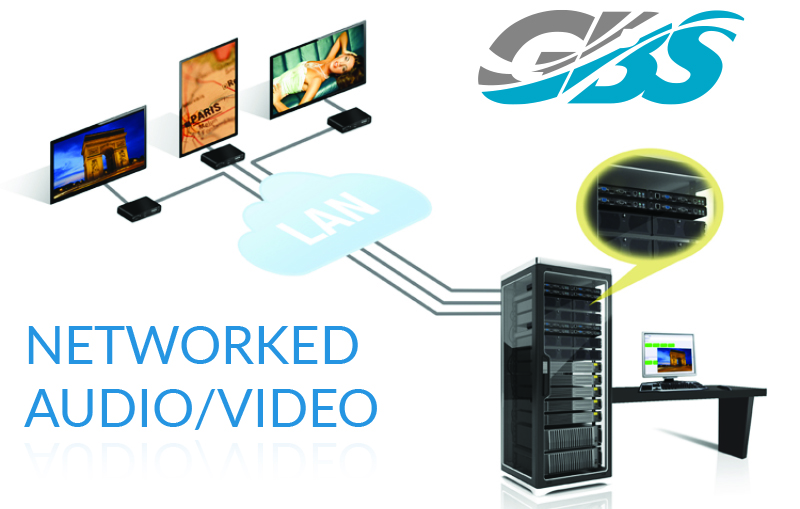Networked AV or AV over IP (Audio-Visual over Internet Protocol) are different monikers for the same technology. This technology delivers the ability to transmit audio, video, metadata, and control signals over your organization’s existing network cable infrastructure – this assumes a Cat6 cabling infrastructure (minimum) which supports 1 Gigabyte bandwidth.
AV Standards Have Changed
ALike many other technologies, the AV industry is rapidly changing. Understanding the differences between AV standards, infrastructures and their practical applications is a key element to making the right decisions. Furthermore, it’s imperative that your investment in AV is successful now and into the future – so let’s start by explaining key differences in the underlying standards – HDBaseT vs. SDVoE
HDBaseT is a leading global connectivity standard used in consumer and commercial AV implementations. It transmits uncompressed, ultra-high-definition audio, video and digital signals to remote displays up to 100 m/328ft via Cat5e or Cat6 cabling. This standard has been used for nearly a decade, enabling high-quality point-to-point installations. Jay Gordon, GBS AV Manager explains, “We use HDBaseT in all of our smaller scale installations. It is the standard used in a room that requires one or two inputs sent to the display on the wall. Installations using HDBaseT use matrixes, switches and cabling infrastructure to transmit the signal.”
Whereas SDVoE (Software Defined Video-over-Ethernet) use internet protocol and an organization’s existing ethernet to bring AV into the realm of IT. “Clearly the way of the future is networked AV, adds Jay Gordon. When an organization requires multiple inputs such as larger rooms with multiple displays or you want to convey information around your facility via digital signage technology or distribute audio and video into an overflow room – these are the telltale signals that your organization is ready for SDVoe.”
According to the SDVoE Alliance, “all AV distribution and processing applications that demand zero-latency, uncompromised video can benefit from SDVoe technology.”
Traditional AV environments use point-to-point (or “baseband”) cable connections and matrix switches in order to transmit AV signals. In comparison, AV over IP uses Ethernet cables and existing network switches to transmit packetized data. This greatly increases the input–output capacity as it is possible to expand the system by adding IP switches and it isn’t limited by the number of available physical inputs. In fact, the ability to run multiple inputs (laptops, wireless presentation systems, video streaming services, video conferencing) to multiple television displays is one of the quintessential advantages networked AV delivers.
It’s important to understand that networked AV is not a jump from analog to digital transmission, but a transition to data packet-based traffic. This traffic requires video data to be compressed or encoding in order for the signal to run effectively on a 1 gigabyte (Cat6) structured cabling infrastructure. To accomplish this, encoders/decoders are used to replaceconventional AV transmitters/receivers at network switch endpoints. Although the workflow is similar between analog and networked AV, one of the many benefits of installing an AV over IP system is often the significant reduction in system-specific cables and dedicated hardware. With AV over IP systems the existing ethernet infrastructure is being utilized. Because of this, it often translates to a significant reduction in total cost of ownership. Networked AV systems offer additional control/management advantages, not to mention the significant expansion in the number of input sources and destinations (displays) that signal can be distributed to.
Networked AV – Signs Your Organization is Ready
Distributing digital audio video signals over your organization’s existing IT network is an innovative approach that delivers flexible, scalable installations that are able to be centrally controlled and managed with the lowest cost of total project ownership.
So, when is Networked Video right for your organization?
1. When you want integrated audio & video office-wide.
2. When you need to distribute presentation content to multiple displays.
3. A Board Room, Conference or Huddle Room requires connection to a number of inputs (sources) with different display (output) destinations. This is a matrixed AV situation.
4. When you’ve investing in structured cabling infrastructure – Cat6 or Cat6A – and you want to fully leverage the infrastructure for its intended purpose.
About GBS Audio Video
- GBS has been successfully deploying full networked audio video systems with zero-latency for years. By understanding the latest in video compression, algorithm and bandwidth requirements, The result – fully distributed 1080p/4K with quality video that boasts a lower total cost of ownership. GBS is proud to partner with QSC, a leader in networked audio video technology.
GBS is a fully integrated technology solutions provider with our roots anchored in IT. At GBS we saw the convergence of digital technology years ago – even before the industry began distributing video over IP. And through this vision, we have multiple IT engineers who are now 100% dedicated to designing and deploying networked AV systems. No traditional AV installer has the depth of network infrastructure knowledge, AV-specific experience and comprehensive structured wiring support within one company. GBS AVIT and Cabling Solutions are unrivaled in the Greater Cincinnati region. No one knows how to successfully execute networked AV better than GBS.
Contact GBS AVIT for a No-Cost Consultation.


